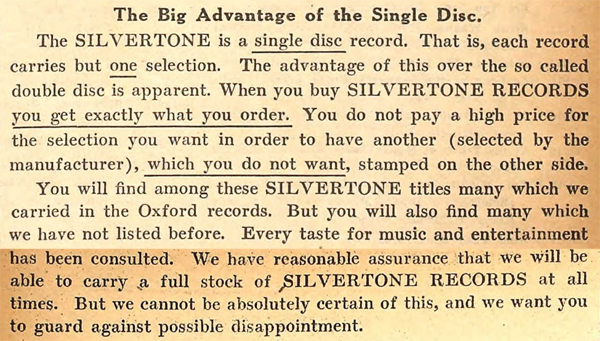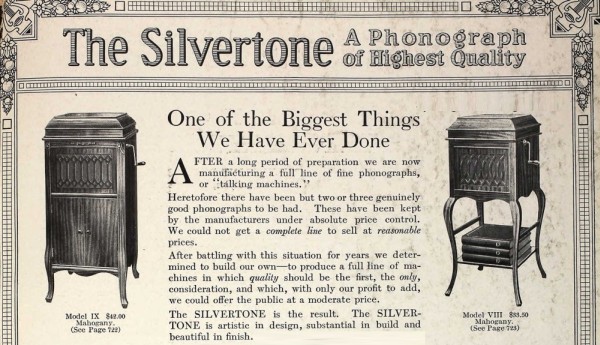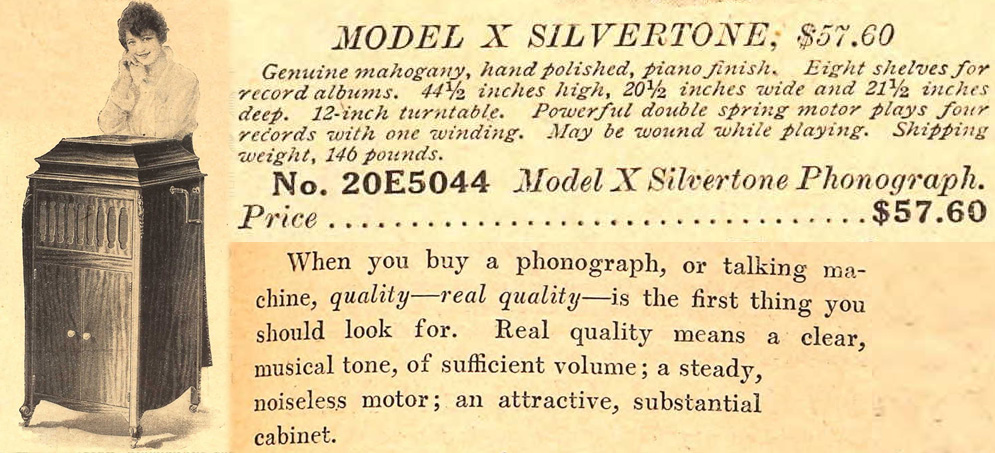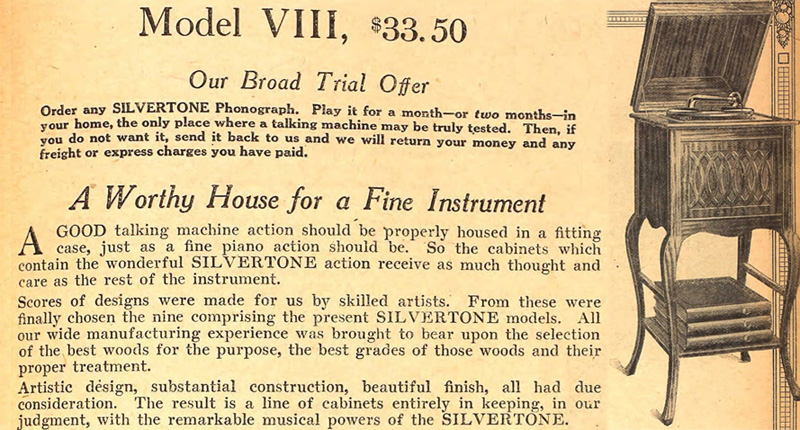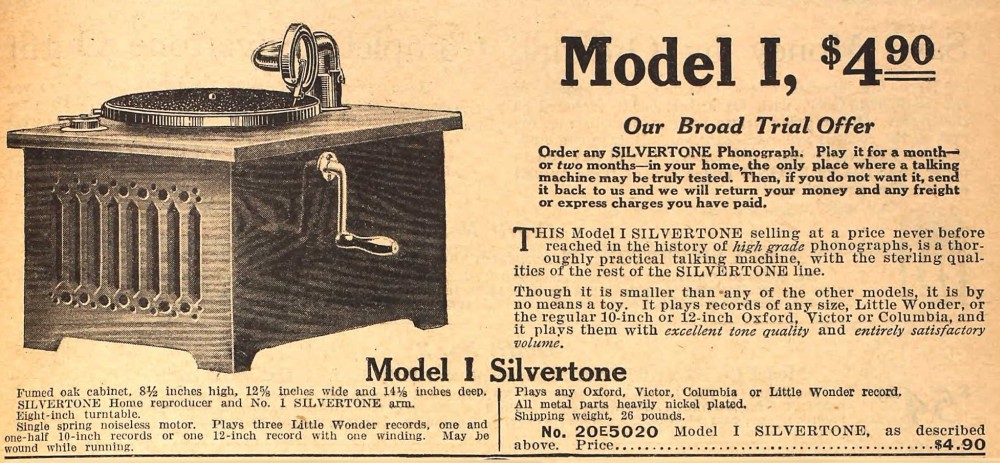1915 and Before
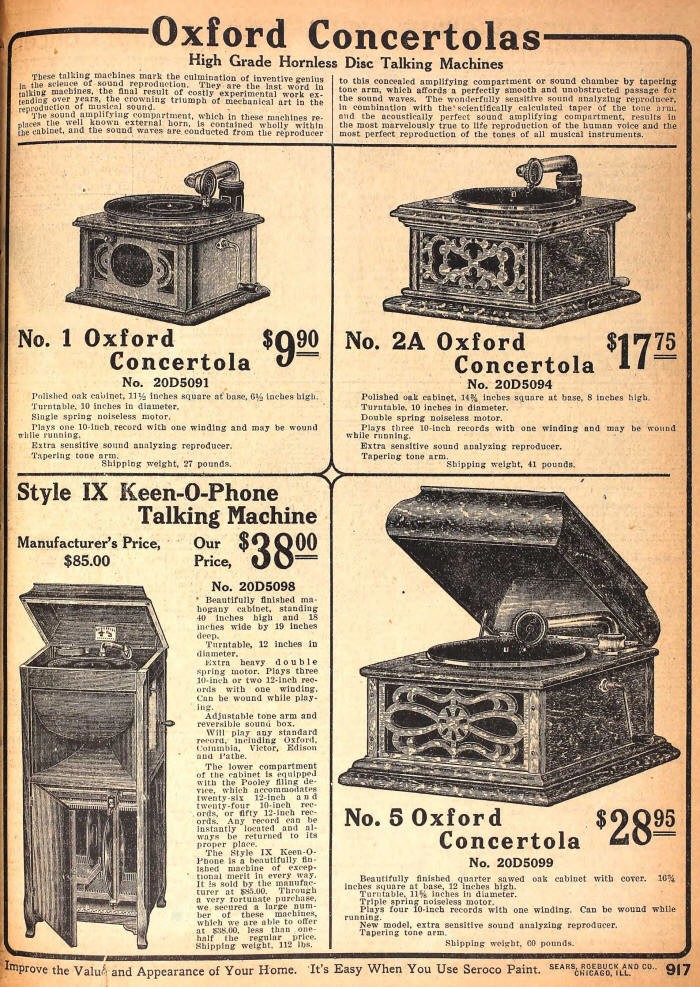 The year was 1915. The Sears &
Roebuck catalog, by now a common fixture in homes across the United
States since its meager introduction over twenty years beforehand,
had over 1,600 pages in its Fall/Winter edition that year. Nearly
everything that one might ever need for home, farm, business,
hobbies, crafts, sports, construction, home decorating, homemaking,
cooking, music.... well... life, both urban and rural,
could be had from within the pages of this catalog. Ordered by mail,
delivered to you by train or truck, with great prices and even some
things that might be a bit pricey available in 'do-able' monthly
installments. This being Silvertone World, we're mainly concerned
with music, and 1915 was the last year that the Silvertone name was
not in the Sears catalog until the early 1970s. The Supertone
moniker was already being applied to the various musical instruments
that Sears was selling, but 'Silvertone?' Nowhere to be seen in the
year of 1915. The 'talking machines' that Sears offered were a
varied lot, with several numbered 'Oxford' concertolas and the
'Keen-O-Phone' joining some unusual but ingenious 'roller organs' to
fill the house with 'automated' music.
The year was 1915. The Sears &
Roebuck catalog, by now a common fixture in homes across the United
States since its meager introduction over twenty years beforehand,
had over 1,600 pages in its Fall/Winter edition that year. Nearly
everything that one might ever need for home, farm, business,
hobbies, crafts, sports, construction, home decorating, homemaking,
cooking, music.... well... life, both urban and rural,
could be had from within the pages of this catalog. Ordered by mail,
delivered to you by train or truck, with great prices and even some
things that might be a bit pricey available in 'do-able' monthly
installments. This being Silvertone World, we're mainly concerned
with music, and 1915 was the last year that the Silvertone name was
not in the Sears catalog until the early 1970s. The Supertone
moniker was already being applied to the various musical instruments
that Sears was selling, but 'Silvertone?' Nowhere to be seen in the
year of 1915. The 'talking machines' that Sears offered were a
varied lot, with several numbered 'Oxford' concertolas and the
'Keen-O-Phone' joining some unusual but ingenious 'roller organs' to
fill the house with 'automated' music. Prior to this last pre-Silvertone year, Sears was still selling a myriad of flat disc as well as cylinder phonographs, more in line with the image we all might conjure when we hear 'gramophone.' Here are a couple of examples from 1910:
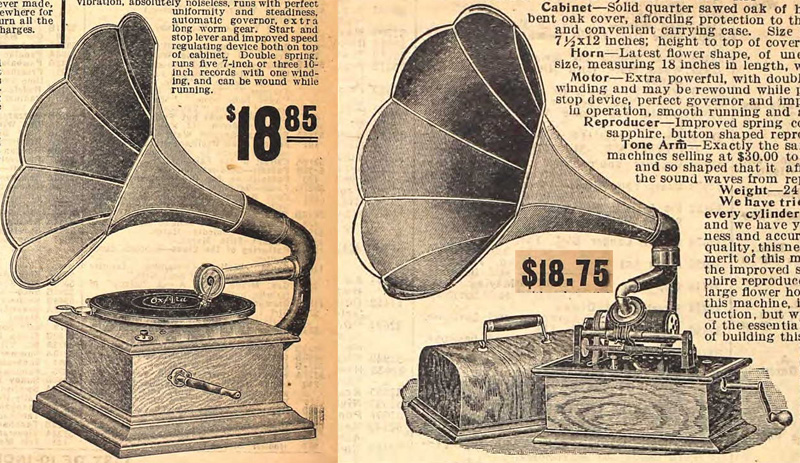 Although 'Silvertone' hadn't appeared on the scene yet, and wouldn't
be applied to guitars and such for several years, Sears was using
'Supertone' for its stringed musical instruments, and by 1915, even
had this snazzy logo:
Although 'Silvertone' hadn't appeared on the scene yet, and wouldn't
be applied to guitars and such for several years, Sears was using
'Supertone' for its stringed musical instruments, and by 1915, even
had this snazzy logo: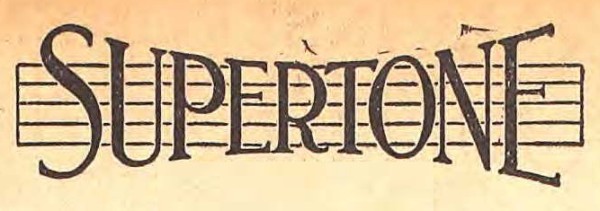
We'll have a few instruments right after the phonographs.
Spring 1916
Sears loved to promote themselves and their products (well, why not ?) and used the catalog as their soapbox, telling you about themselves, their vast industrial resources and their relentless commitment to quality. Here's the first Silvertone essay: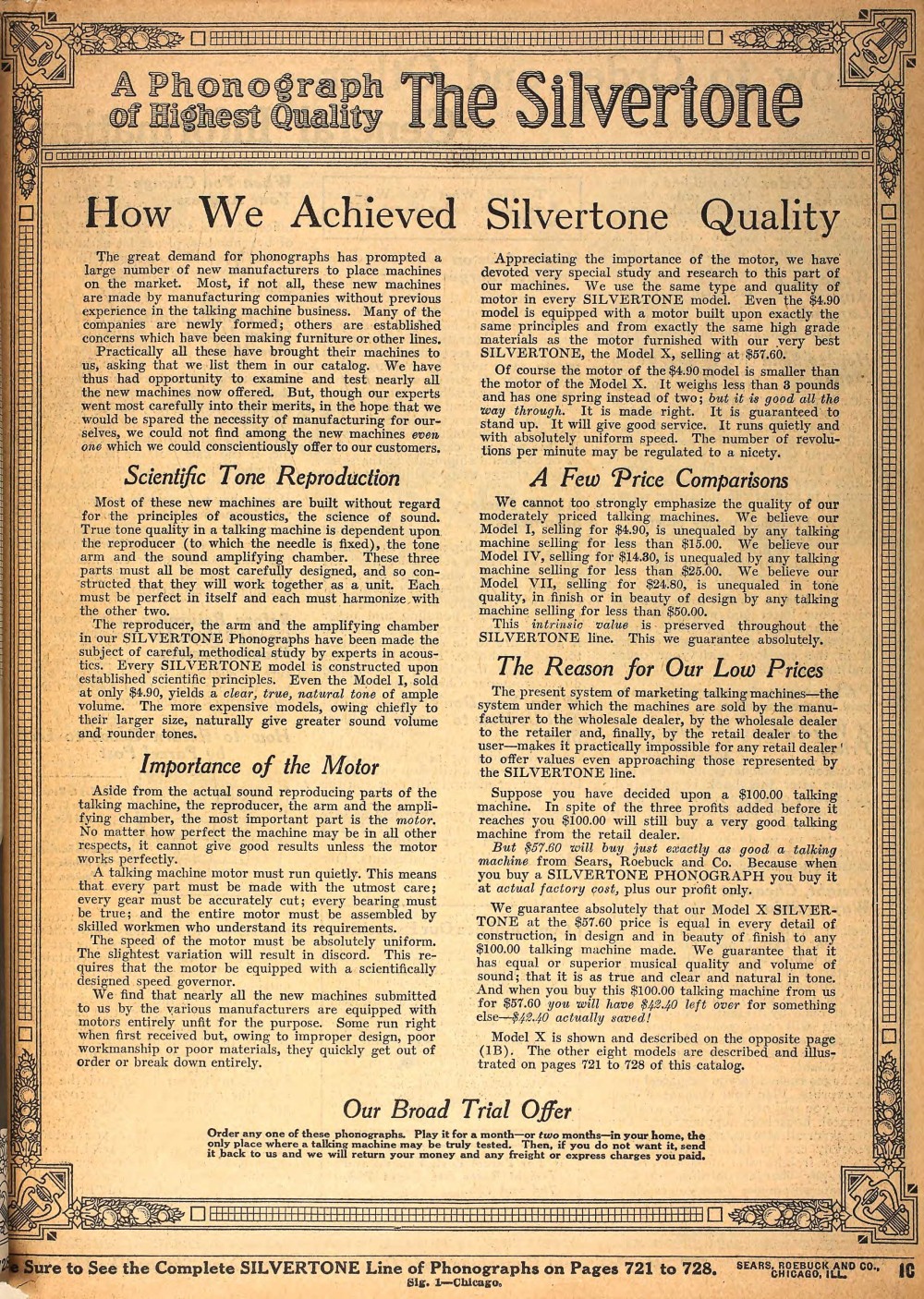 In
the spring catalog, Sears declared their 'independence' from the
suppliers of phonographs, claiming they couldn't sell them to their
customers at the price they wanted and had decided to go their own
way, with a line of phonographs they named 'Silvertone.' There were
several models made available, from large pieces of well-made
furniture, to smaller table top models. In addition to the
phonographs themselves, all manner of accessories, repair parts and
records also appeared in the catalog. During the early days of
phonographic recording, there were mainly two competing systems,
Edison's 'hill
and dale' vertical cut grooves, and the (eventually
triumphant) lateral cut, which the Silvertone line favored (think of
it as the Beta/VHS battle of it's day).
In
the spring catalog, Sears declared their 'independence' from the
suppliers of phonographs, claiming they couldn't sell them to their
customers at the price they wanted and had decided to go their own
way, with a line of phonographs they named 'Silvertone.' There were
several models made available, from large pieces of well-made
furniture, to smaller table top models. In addition to the
phonographs themselves, all manner of accessories, repair parts and
records also appeared in the catalog. During the early days of
phonographic recording, there were mainly two competing systems,
Edison's 'hill
and dale' vertical cut grooves, and the (eventually
triumphant) lateral cut, which the Silvertone line favored (think of
it as the Beta/VHS battle of it's day).
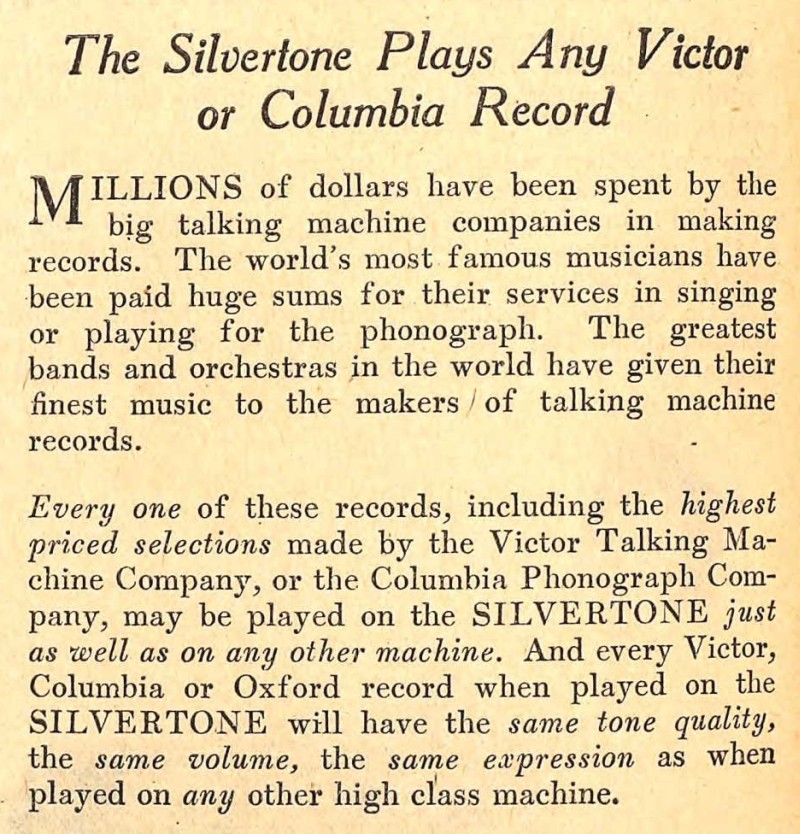
1916 Model X
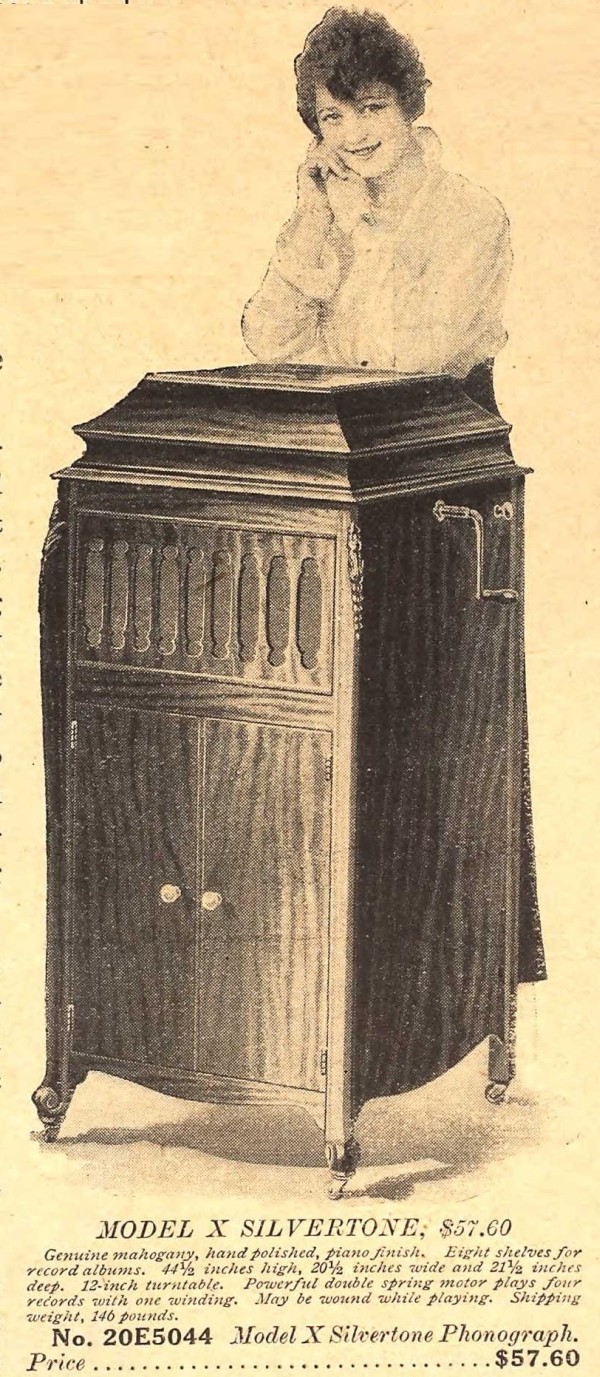
Let's run down the entire line of the first batch of phonographs
that Sears made available in that pivotal year of 1916 in the
Spring catalog. First up is the Model X, the top of the line in
the series. A substantial piece, nearly four feet high, with
a double-spring hand-cranked motor that would give you four
records' worth of play from one full cranking. Concealed shelves
gave you plenty of storage for your records, with rollers on the
legs so you could enjoy music from the porch to the parlor. While
$58 doesn't look like much to us for this lovely
piece, it was the hefty equivalent of $1263 USD in 2015
according to the US Inflation Calculator; obviously a luxury
purchase.
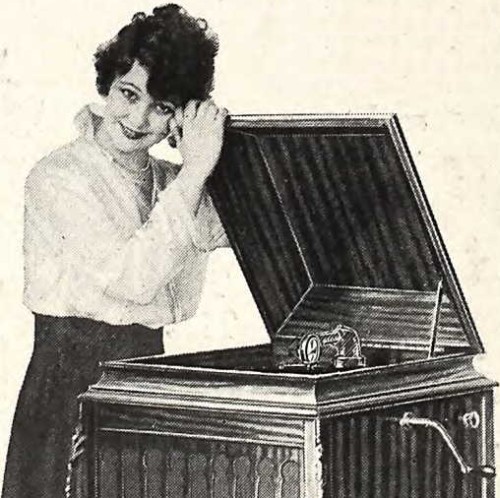
1916 Model IX
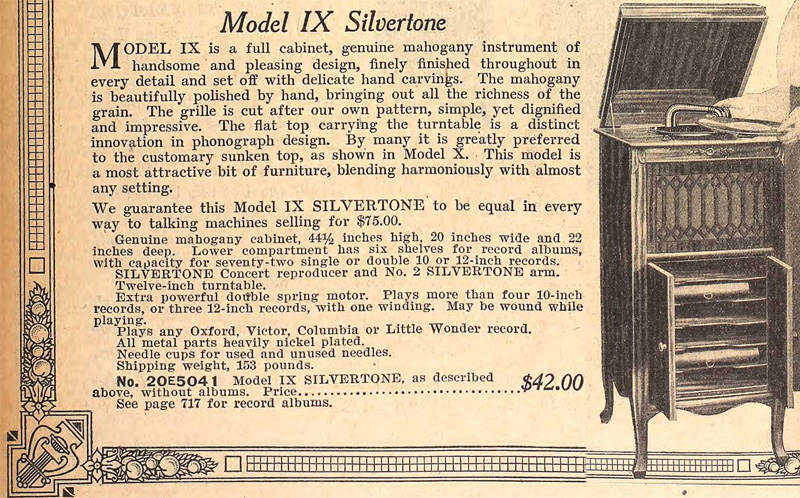 The Model IX (I guess the Roman
numeral designations gave them some perceived 'class') distinguished
itself with a flat-top table supporting the turntable mechanism, as
opposed to the more expensive build of a sunken table in the Model
X. Other than that, the specs are pretty similar, but it looks like
the double-spring motor will only give you three 10-inch plays per
winding. No wheels on the legs, though, and only six shelves for
your records. $42=$915 USD in 2015.
The Model IX (I guess the Roman
numeral designations gave them some perceived 'class') distinguished
itself with a flat-top table supporting the turntable mechanism, as
opposed to the more expensive build of a sunken table in the Model
X. Other than that, the specs are pretty similar, but it looks like
the double-spring motor will only give you three 10-inch plays per
winding. No wheels on the legs, though, and only six shelves for
your records. $42=$915 USD in 2015.1916 Model VIII
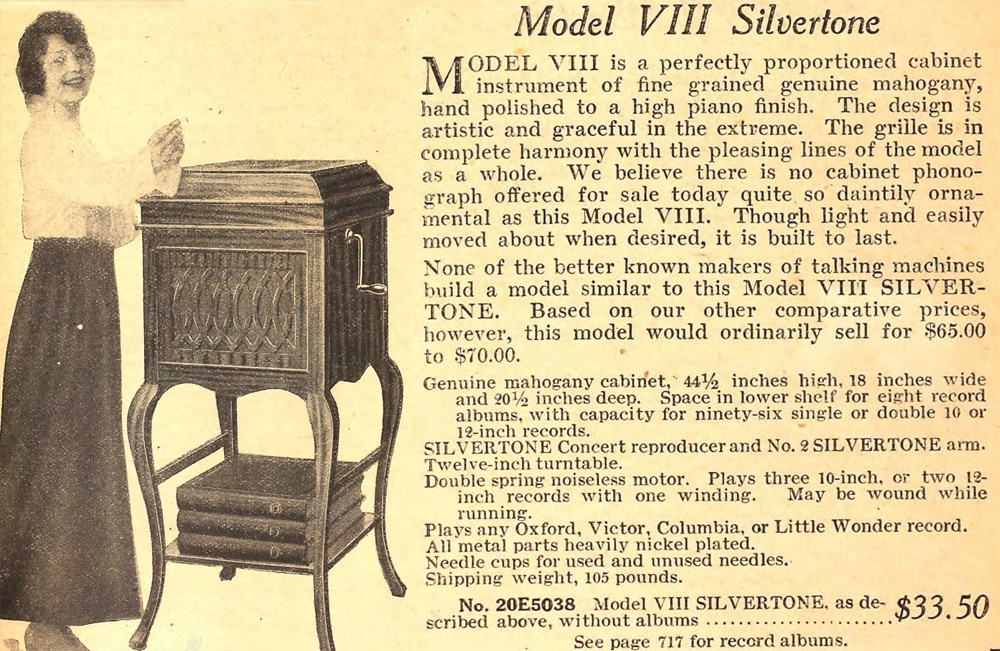 Fancy curved legs, with
a single shelf to support your records (three stacked 'albums' shown
here), top-of-the-table construction, three 10-inch plays per
winding just like the IX.
Fancy curved legs, with
a single shelf to support your records (three stacked 'albums' shown
here), top-of-the-table construction, three 10-inch plays per
winding just like the IX. $34=$741 USD in 2015.
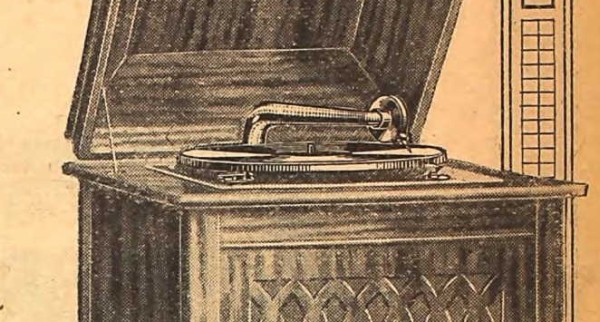
1916 Model VII
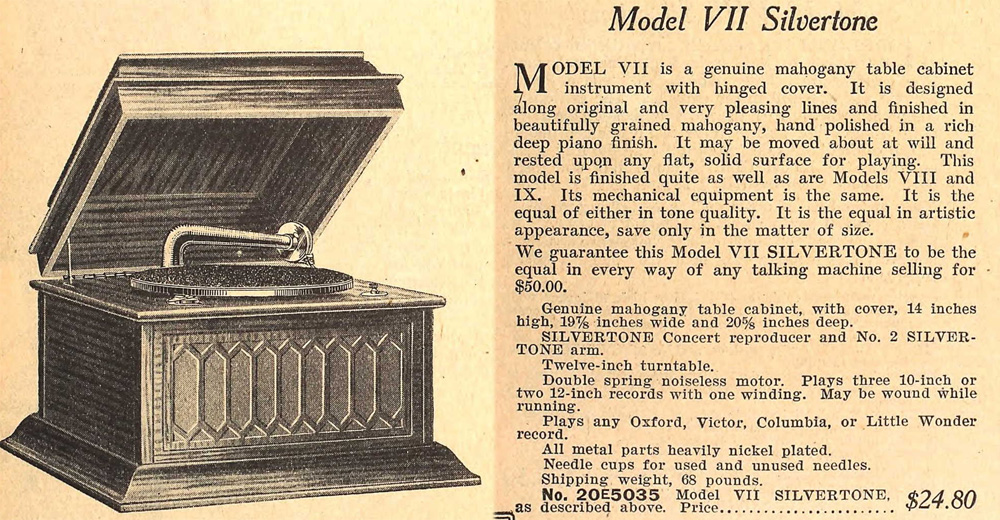
Now to the tabletop models, starting with the Model VII. The
catalog listing compares it features favorably to the VIII and IX,
save for size.
$25=$545 USD in 2015.
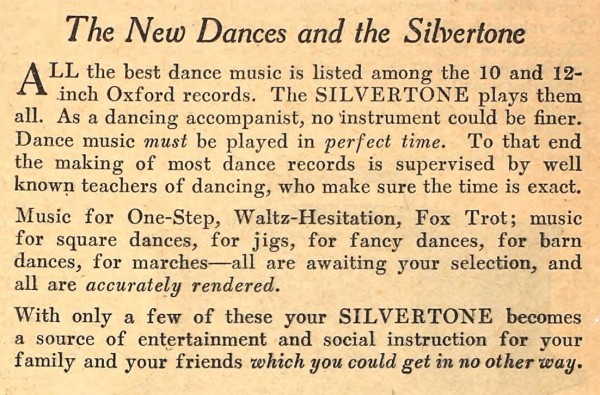
1916 Model VI
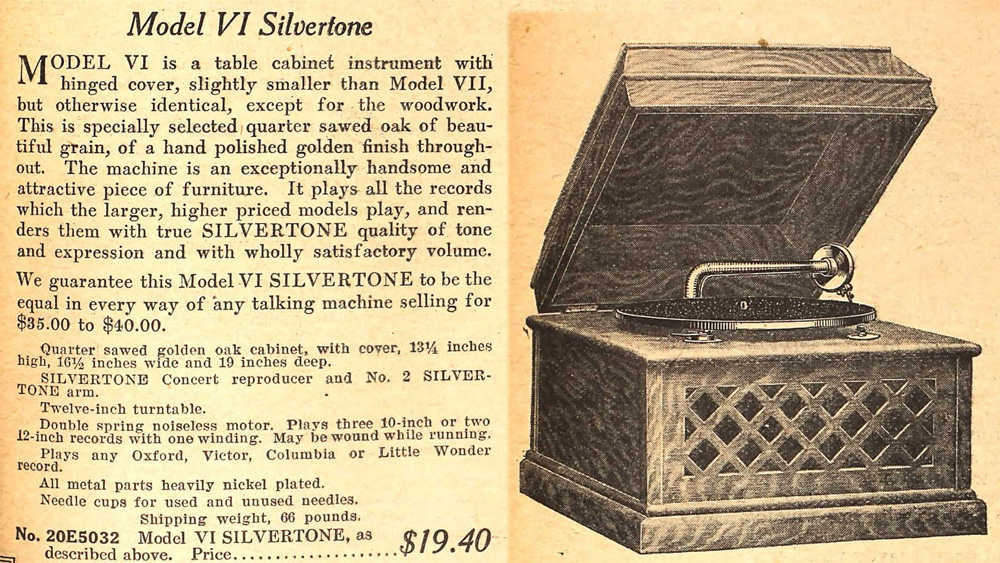 The big change with the Model VI
is quarter-sawn oak replacing the mahogany of all previous models,
and "slightly smaller, but otherwise identical to the model VII."
The big change with the Model VI
is quarter-sawn oak replacing the mahogany of all previous models,
and "slightly smaller, but otherwise identical to the model VII." $20=$436 USD in 2015.
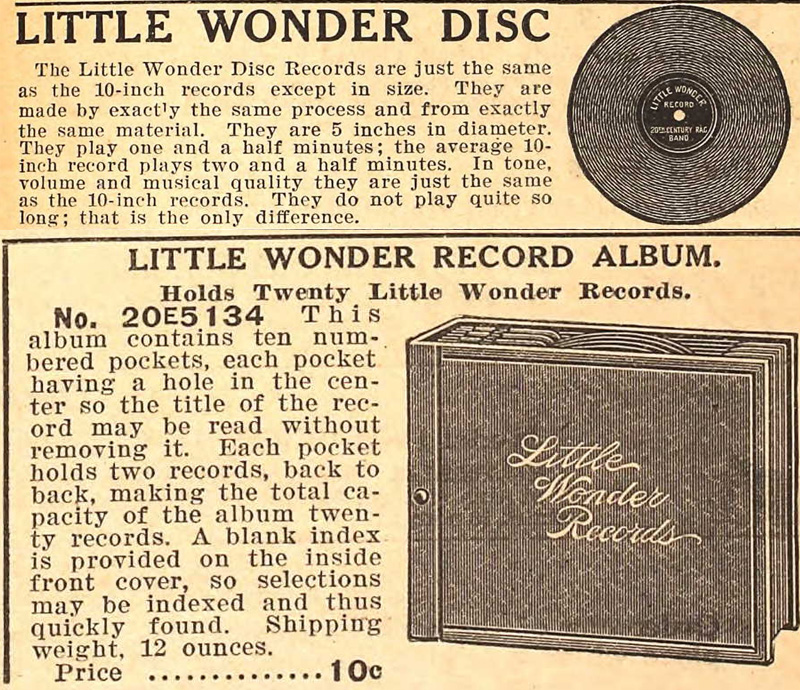
1916 Model IV
 Not sure why there's no Model V,
but it jumps right over to IV in the Spring 1916 catalog. At this
level, we've gone 'topless.'
Not sure why there's no Model V,
but it jumps right over to IV in the Spring 1916 catalog. At this
level, we've gone 'topless.' $15=$327 USD in 2015.
1916 Model III
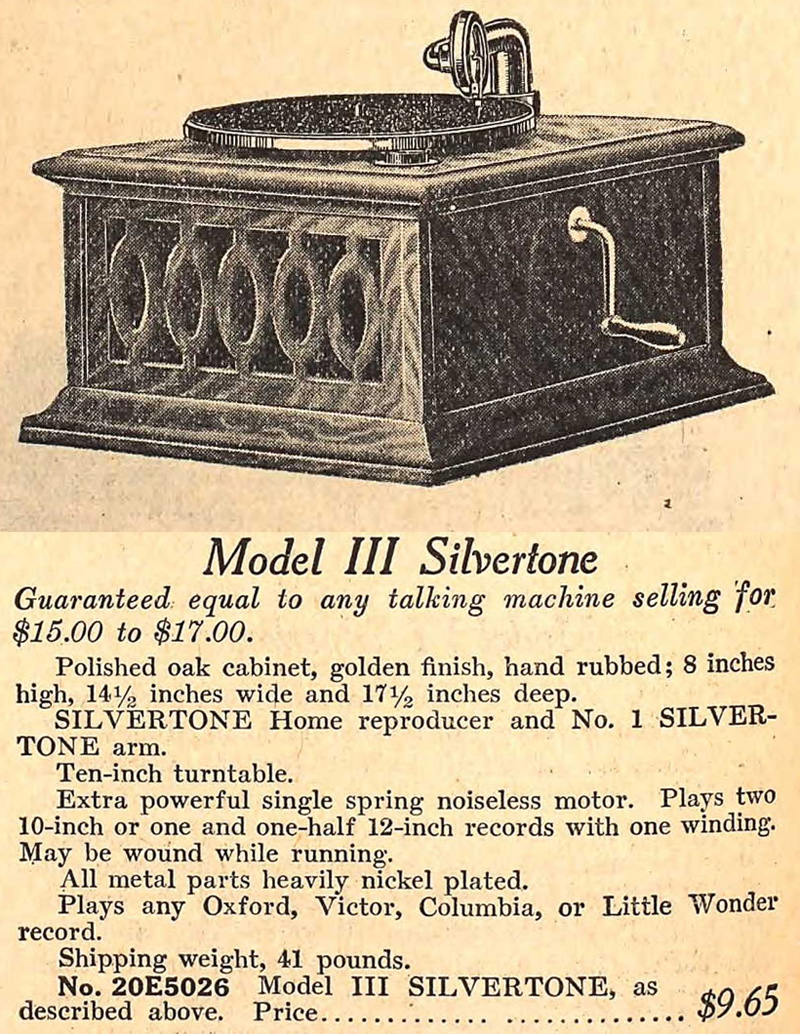
Now to a 'polished oak' and a smaller turntable, two 10-inch
plays per winding on the now single spring motor.
$10=$218 USD in 2015.
1916 Model II
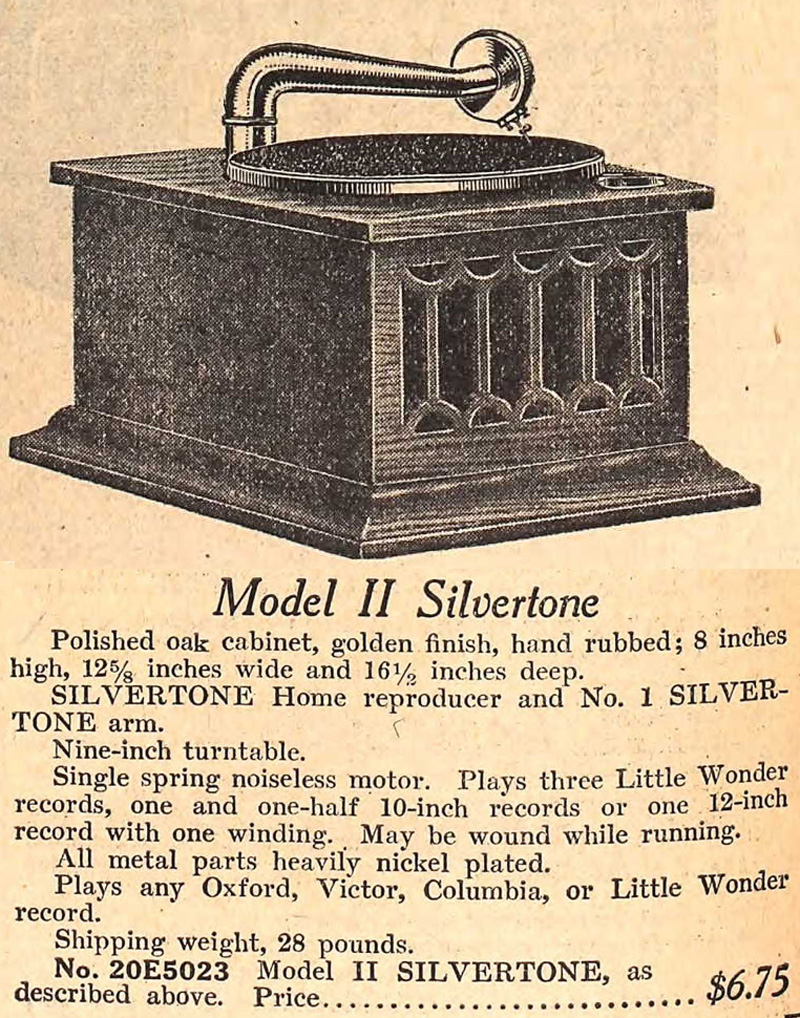
The turntables keep getting smaller in diameter as the price goes down; 9-incher on the Model II. $10=$218 USD in 2015.
1916 Model I
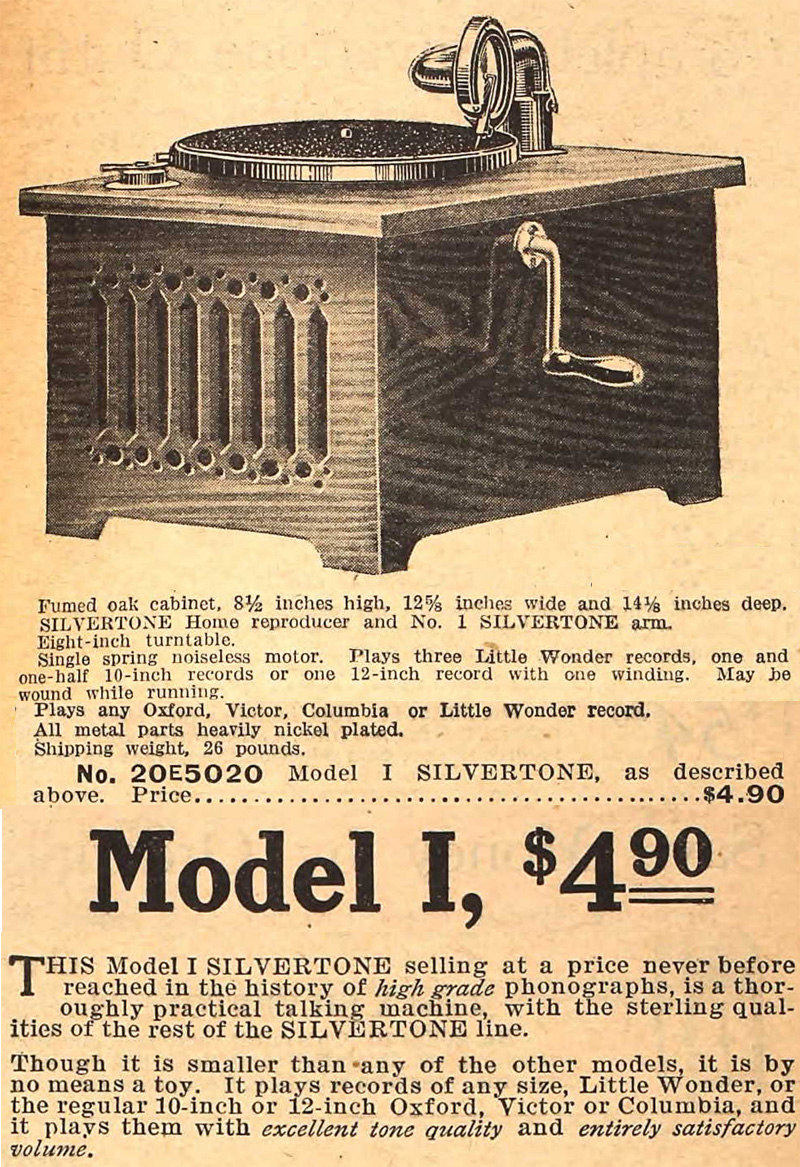
Lastly, the budget-minded Model I. "Fumed oak" cabinet, 8-inch turntable, and the single-spring motor will get you one full play of a 12-inch disc.
$5=$109 USD in 2015.
1916
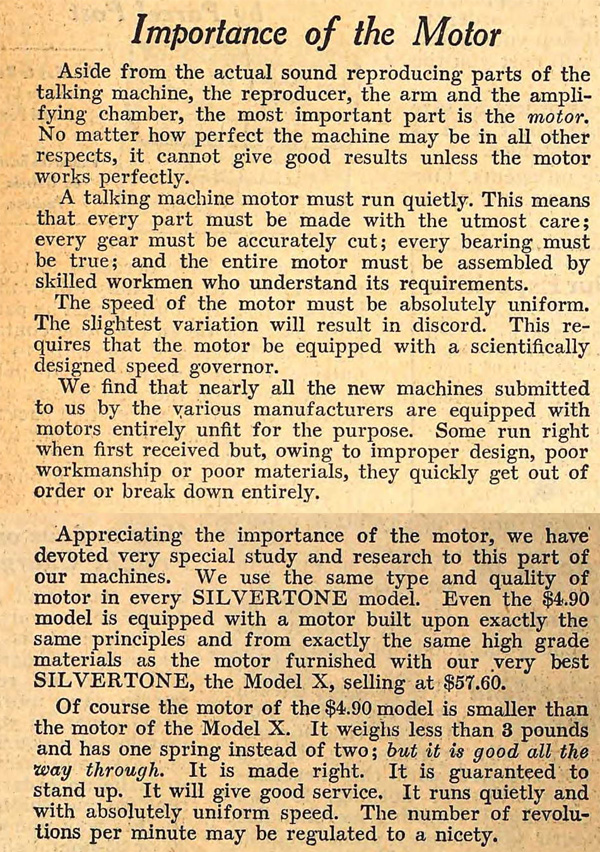
Sears catalogs seemed to be as much encyclopedias as they were
catalogs back then.
1916
There were also fascinating accessories sold, like this Haile's Modulator, that isolated the playing needle in a rubber sleeve, attenuating the vibration transmitted to the phonograph reproducer, and also 'gave' enough to lessen the impact of a steel needle riding through the grooves of your records.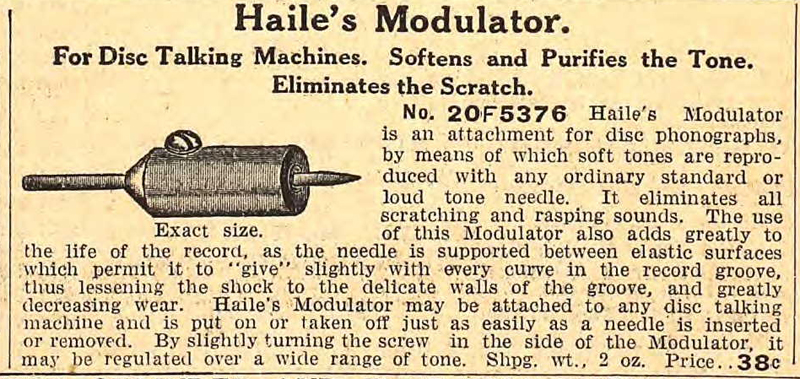
Or the "Tusko" brand phonograph needle, made from a cactus thorn!

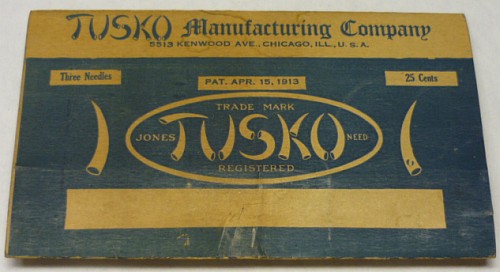
Fall 1916
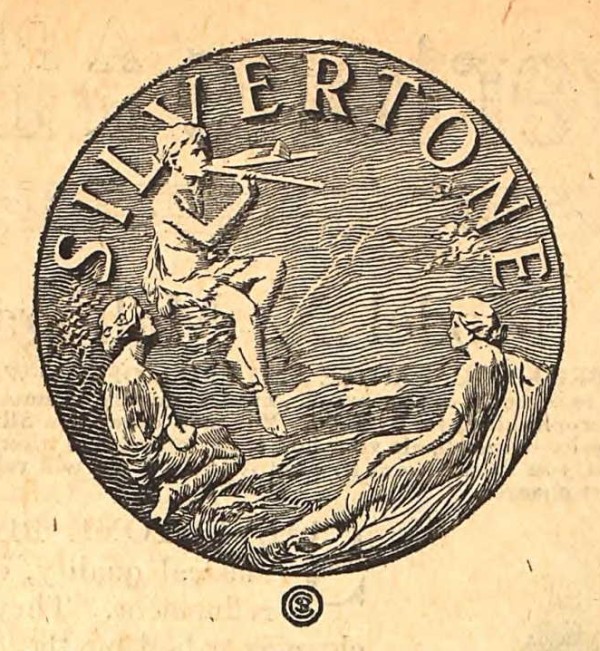
The Sears Marketing Department comes up with the first Silvertone logo featuring this little sprite playing the aulos for his audience. Depending on the model, you might get a gold Silvertone decal with the cursive logo, or an inlaid stamped medallion with the aulos player.

1916
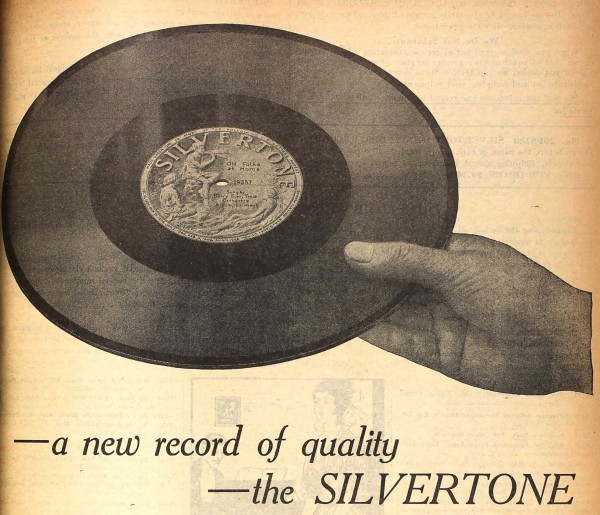
Fall 1916 also saw the introduction of the Silvertone record label, featuring the new logo. They were initially one-sided discs, and Sears was happy to explain the advantage of this.
